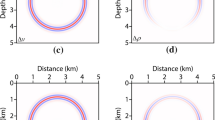Abstract
Traditional least-squares reverse time migration (LSRTM) often aims to improve the quality of seismic imaging, such as removing the acquisition footprint, suppressing migration artifacts and enhancing resolution. In this paper, we find that the conventional reflectivity defined in the LSRTM is related to the normal-incident reflection coefficient and the background velocity. Compared with the defined reflectivity, our inverted result is relatively “true”. With reflected data, LSRTM is mainly sensitive to impedance perturbations. According to an approximate relationship between them, we reformulate the perturbation related system into a reflection-coefficient related one. Then, we seek the inverted image through linearized iteration. Moreover, with the assumption that the density varies more gradually than the migration velocity, only the knowledge of the latter is required, although the reflected waves are produced at impedance discontinuities. We test our method using the 2D Marmousi synthetic dataset.
Similar content being viewed by others
References
Beylkin G., Oristaglio M. and Miller D., 1985. Spatial resolution of migration algorithms. In: Berkhout A.J., Ridder J. and van der Wal L.F.(Eds), Acoustical Imaging, 14, Springer, Boston, MA, 155–168.
Claerbout J.F., 1992. Earth Soundings Analysis: Processing versus Inversion. Blackwell Science.
Clapp M.L., Clapp R.G. and Biondi B.L., 2005. Regularized least-squares inversion for 3-D subsalt imaging. SEG Technical Program Expanded Abstracts 2005, 1814–1817.
Dai W. and Schuster G., 2013. Plane-wave least-squares reverse-time migration. Geophysics, 78, S165–S177.
Dutta G. and Schuster G., 2014. Attenuation compensation for least-squares reverse time migration using the visco-acoustic wave-equation. Geophysics, 79, S251–S262.
Guitton A., Valenciano A., Bevc D. and Claerbout J., 2007. Smoothing image condition for shotprofile migration. Geophysics, 72, S149–S154.
Huang Y. and Schuster G.T., 2012. Multisource least-squares migration of marine streamer data and land data with frequency-division encoding. Geophys. Prospect., 60, 663–680.
Huang Y., Dutta G., Dai W., Wang X., Schuster G.T. and Yu J., 2014. Making the most out of leastsquares migration. Leading Edge, 33, 954–960.
Kaplan S.T., Routh P.S. and Sacchi M.D., 2010. Derivation of forward and adjoint operators for least-squares shot-profile split-step migration. Geophysics, 75, S225–S235.
Kuehl H. and Sacchi M., 2002. Robust AVP estimation using least-squares wave-equation migration. SEG Technical Program Expanded Abstracts 2002, 281–284.
Lailly P., 1983, The seismic inverse problem as a sequence of before stack migrations. In: Bednar J.B., Redner R., Robinson E. and Weglein A. (Eds), Conference on Inverse Scattering-Theory and Application. Society for Industrial and Applied Mathematics, Philadelphia, 206–220.
Liu S., Li X., Wang W. and Zhu T., 2015. Source wavefield reconstruction using a linear combination of the boundary wavefield in reverse time migration. Geophysics, 80, S203–S212.
Liu Q., Zhang J. and Gao H., 2017. Reverse-time migration from rugged topography using irregular, unstructured mesh. Geophys. Prospect., 65, 453–466.
Nemeth T., Wu C. and Schuster G.T., 1999. Least-squares migration of incomplete reflection data. Geophysics, 64, 208–221.
Plessix R.E., 2006. A review of the adjoint-state method for computing the gradient of a functional with geophysical applications. Geophys. J. Int., 167, 495–503.
Plessix R.E. and Li Y., 2013. Waveform acoustic impedance inversion with spectral shaping. Geophys. J. Int., 195, 301–314.
Plessix R.E. and Mulder W.A. 2004. Frequency-domain finite difference amplitude preserving migration. Geophys. J. Int., 157, 975–987.
Schuster G.T., 1993. Least-squares cross-well migration. SEG Technical Program Expanded Abstracts 1993, 110–113.
Tan S. and Huang L., 2014. Least-squares reverse-time migration with a wavefield-separation imaging condition and updated source wavefields. Geophysics, 79, S195–S205.
Tang Y., 2008. Wave-equation Hessian by phase encoding. SEG Technical Program Expanded Abstracts 2008, 2201–2205.
Ten Kroode F., 2012. A wave-equation-based Kirchhoff operator. Inverse Probl., 28, 115013, DOI: 10.1088/0266-5611/28/11/115013.
Virieux J., 1986. P-SV wave propagation in heterogeneous media, velocity-stress finite difference method. Geophysics, 51, 889–901.
Virieux J. and Operto S, 2009. An overview of full-waveform inversion in exploration geophysics. Geophysics, 74, WCC127–WCC152.
Wang J. and Sacchi M.D., 2007. High-resolution wave equation AVP imaging with sparseness constraints. Geophysics, 72, S11–S18.
Wang J., Kuehl H. and Sacchi M.D., 2005. High-resolution wave-equation AVA imaging: Algorithm and tests with a data set from the Western Canadian Sedimentary Basin. Geophysics, 70, S91–S99.
Zhang Y., Duan L. and Xie Y., 2015. A stable and practical implementation of least-squares reverse time migration. Geophysics, 80, V23–V31.
Zhang Y., Ratcliffe A., Roberts G. and Duan L., 2014. Amplitude-preserving reverse time migration: From reflectivity to velocity and impedance inversion. Geophysics, 79, S271–S283.
Author information
Authors and Affiliations
Corresponding author
Rights and permissions
About this article
Cite this article
Lu, Y., Liu, X. An approximate least squares reflectivity inversion in the presence of density. Stud Geophys Geod 62, 364–379 (2018). https://doi.org/10.1007/s11200-017-1247-8
Received:
Revised:
Accepted:
Published:
Issue Date:
DOI: https://doi.org/10.1007/s11200-017-1247-8



